“When I used to read fairy tales, I fancied that kind of thing never happened, and now here I am in the middle of one!”
—Chapter 4, The Rabbit Sends in a Little Bill – Alice’s Adventures in Wonderland
Bluish grey ripples of reflected water danced on the branches above their heads as the tiny boat carrying Alice and her two sisters drifted carelessly down the river Thames towards Oxford. Edith and Lorina giggled persistently as Mr Dodgson, a mathematics professor at the nearby university, regaled the children with fantastical stories about another Alice whose adventures led her down a rabbit hole and into a magical universe filled with ludicrous characters and equally bizarre escapades. Alice Liddell was the 10-year-old daughter of Henry George Liddell, the then dean of Christ Church, the largest college of Oxford University. Transfixed by Mr Dodgson’s narrative Alice listened most attentively as he described in vivid detail the furry grey stripes and broad grin stretched across the Cheshire’s feline face. It is said that when the girls returned to Oxford on that summer’s day in 1862 with Mr Dodgson and his friend Robinson Duckworth that Alice asked the professor to write his stories down on paper and eventually Alice and her whimsical adventures in Wonderland would become immortalised in the minds of children all around the world.
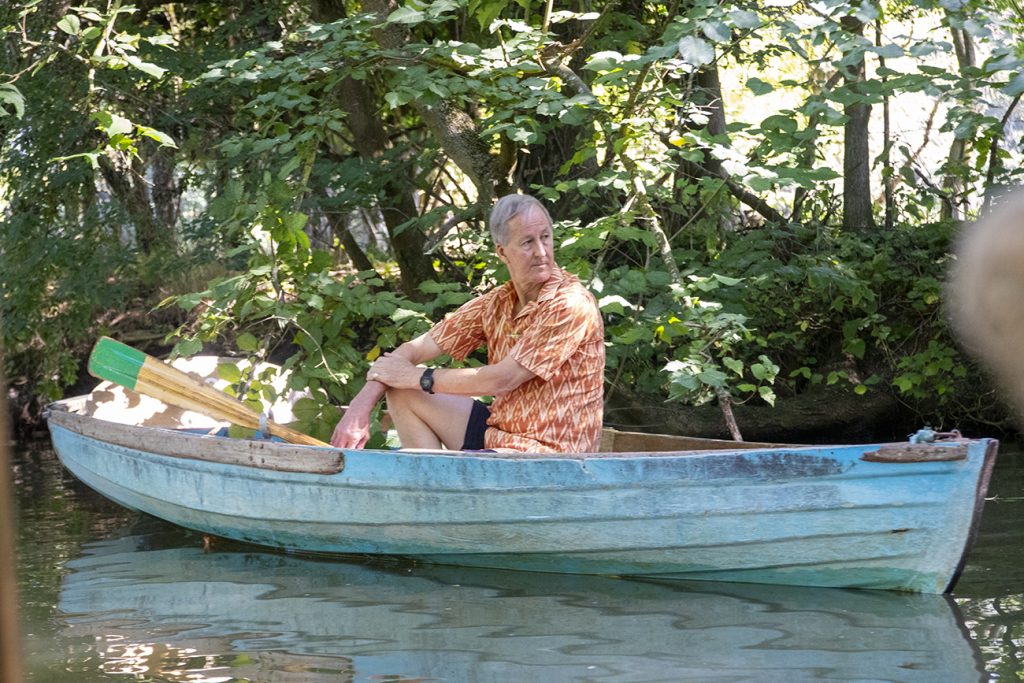
Oxford has become synonymous with famous literary greats such as Oscar Wilde and Charles Lutwidge Dodgson (who you may better recognise by his pen name of Lewis Carroll) and the university town is renowned for its academic achievements, educating some 28 Nobel Prize winners. Writers such as these have forever etched into our minds the storybook beauty and mysterious allure that the town seems destined to possess. I have come to Oxford to experience a tiny piece of that childhood wonder and to revel in the old-world atmosphere. And just like Alice, we all need a little escapism from the everyday – even if it is just for a long weekend.

“Would you tell me, please, which way I ought to go from here?”
“That depends a good deal on where you want to get to,” said the Cat.
“I don’t much care where—” said Alice.
“Then it doesn’t matter which way you go,” said the Cat.
“—so long as I get somewhere,” Alice added as an explanation.
“Oh, you’re sure to do that,” said the Cat, “if you only walk long enough.”
—Chapter 6, Pig and Pepper
In my previous post we wandered the town’s ancient, cobbled streets in search of somewhere lovely to have lunch. Dan and I discovered the picture-perfect setting of the Vaults & Garden café where we enjoyed a mouth-watering meal overlooking the grandiose architecture that flanks the much-visited Radcliffe Square. A mind-boggling tour through the cabinets of scientific curiosities housed within the Natural History Museum was the perfect ending to our first day in Oxford.


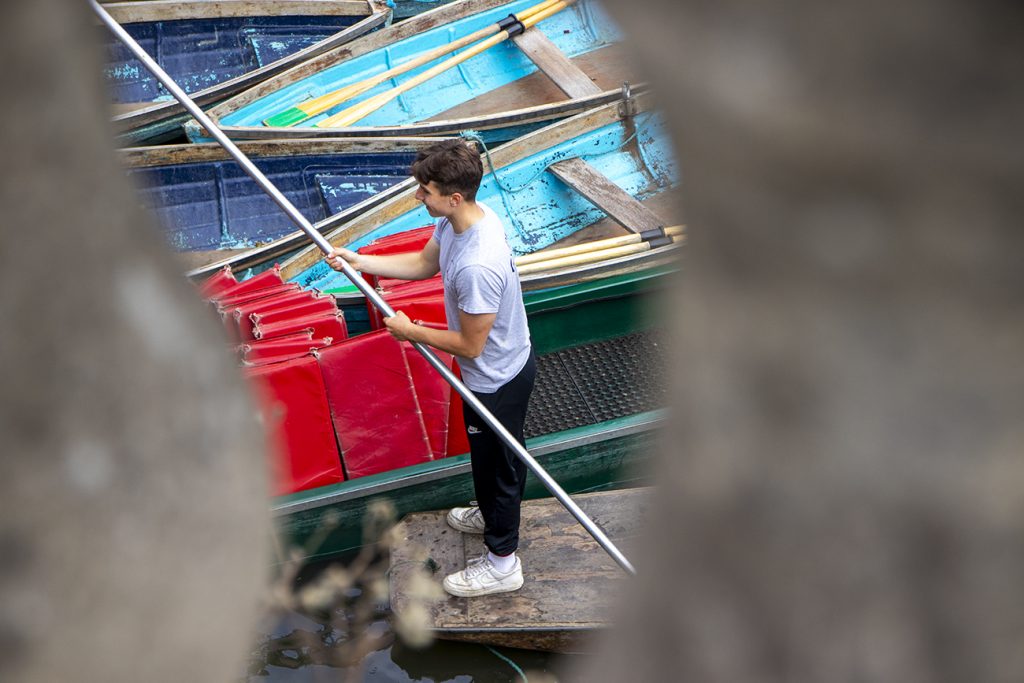
To save the best until last ensures your departure from any destination will be a sweet one. However, in Oxford each experience seems committed to outdo the last no matter which order they occur. We did however feel determined to save the quintessential boat trip that follows Alice’s escapades down the Thames until the second day– an attempt to savour every tranquil moment spent gliding along the very same university Regatta trail that thousands of fresh-faced students have journeyed before. We noted that the route offers a fascinating stretch of river along the university regatta course towards quaint Iffley village, passing by the ancient Folly Bridge, Christchurch College and Meadows, as well as the university rowing houses. This part of the river known as the Isis is one of the busiest and most colourful stretches of the Thames. Rowing eights, punts, university boats and large pleasure cruisers come together here in a lively display.
“In that direction,” the Cat said, waving its right paw round, “lives a Hatter: and in that direction,” waving the other paw, “lives a March Hare. Visit either you like: they’re both mad.”
“But I don’t want to go among mad people,” Alice remarked.
“Oh, you can’t help that,” said the Cat: “we’re all mad here. I’m mad. You’re mad.”
“How do you know I’m mad?” said Alice.
“You must be,” said the Cat, “or you wouldn’t have come here.”
—Chapter 6, Pig and Pepper

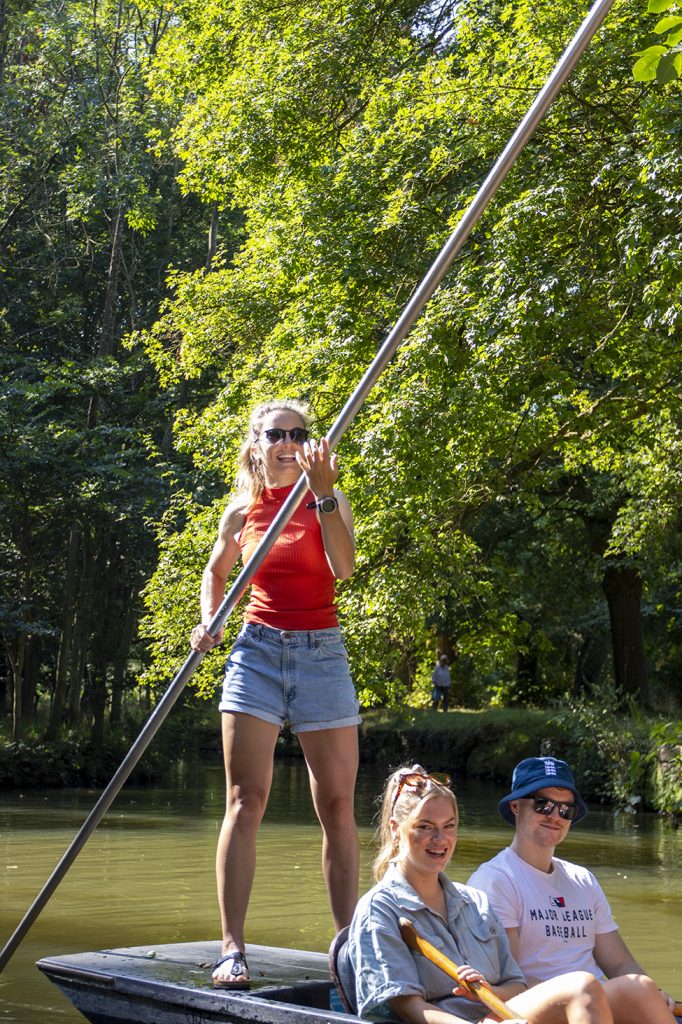
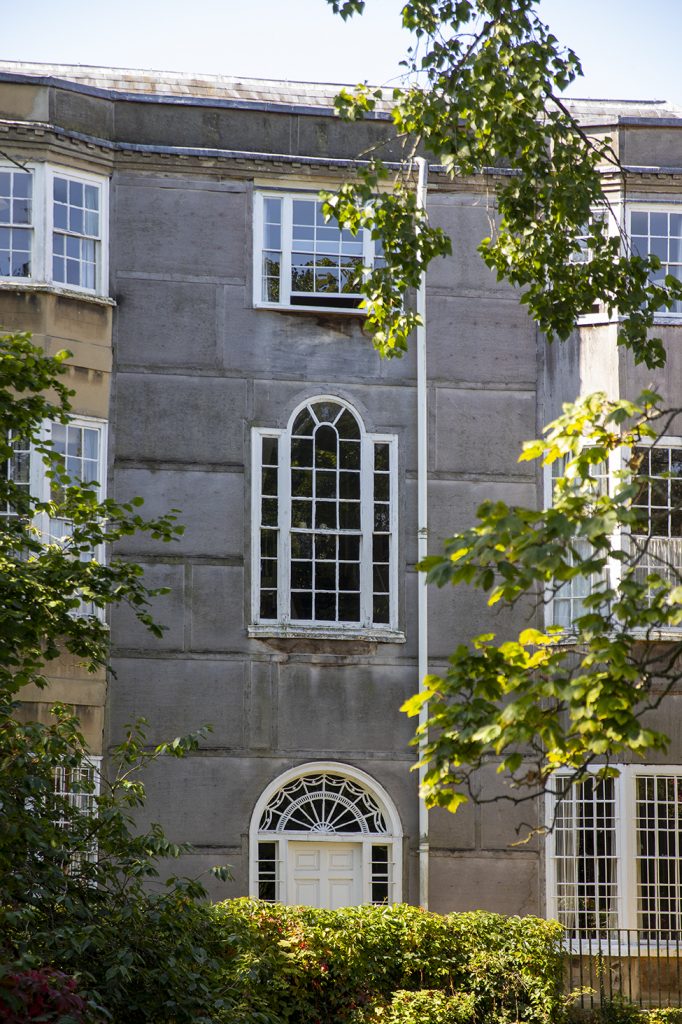
We meet our captain and fellow sightseers down by the dock in front of a glass fronted riverside restaurant. With just enough time to enjoy the calm of the water before our host arrives, we spy a perfectly placed family of ducks as they glide by, completely unfazed by our presence and non plussed by the sudden camera clicks. I wonder privately at the stereotypical scene and imagine some young skipper crouched behind the bridge in anticipation for the arrival of the tourists and the moment when he can ‘release’ the ducks. Dan and I overhear one of the other guests, a rather sweet looking older lady, tell her companion that ‘Isn’t it so idyllic!”. We chuckle softly in the absurdity of our common mood and agree wholeheartedly that Oxford is absolutely Idyllic with a capital I.

The perfection of the previous day appears determined to ensue, as our boat, a little bigger and presumably more modern than Alice’s, edges slowly past classic scenes lifted straight from the pages of one of Carroll’s novels. Although there is no mention of the university or much of the scenery that we are witnessing in the books, I still feel completely immersed in Carroll’s landscape as the writer transcends Alice from the realty of her childhood into the magical world down at the bottom of that famous rabbit hole. I glance upwards into the dense Hawthorn branches that overhang the river here and there, elegantly fringing the riverbank on either side. I find myself mesmerised by that same dappled bluish grey light reflecting on the woody limbs, and I begin to imagine how Alice Liddell felt back in 1862, and how Mr Dodgson’s lyrical accounts must have transported her into another world, perhaps a world more exciting than her own. I once again reflect that Oxford remains as it was then, and in contrast to the scientific discoveries that hail from the university, the town has barely changed over the centuries. The skyline is still punctuated with a thousand gothic spires and the low-lying grassy meadows are, as always, carpeted in a flourish of wildflowers and grazing cows in the summertime. Oxford seems a rather easy place to become swept up in the fantasy of it all and it is not difficult to see how the idyllic landscape here ignited the creative imagination of the Oxford Inklings such as Lewis Carroll, C.S. Lewis, and J.R.R. Tolkien.
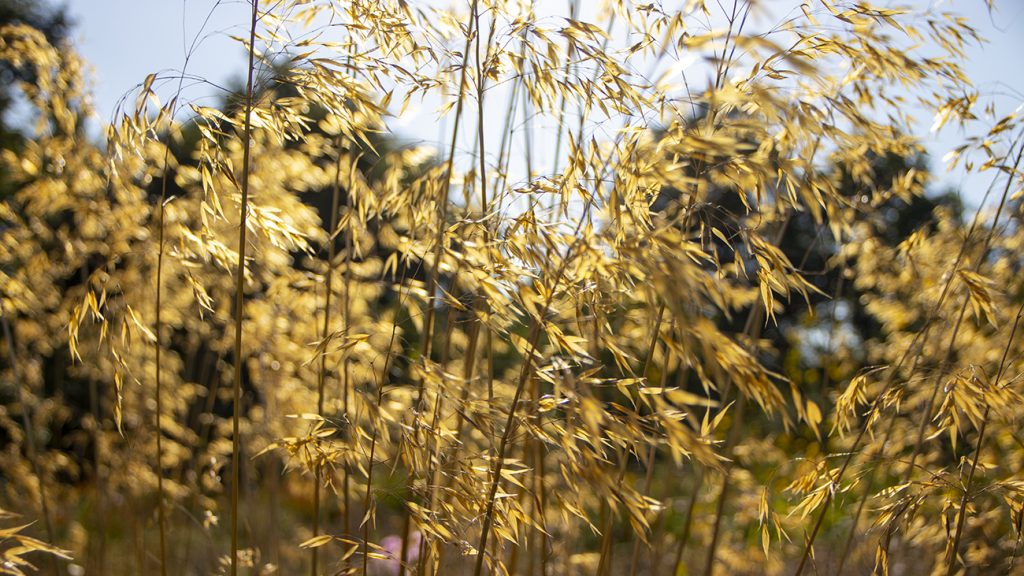

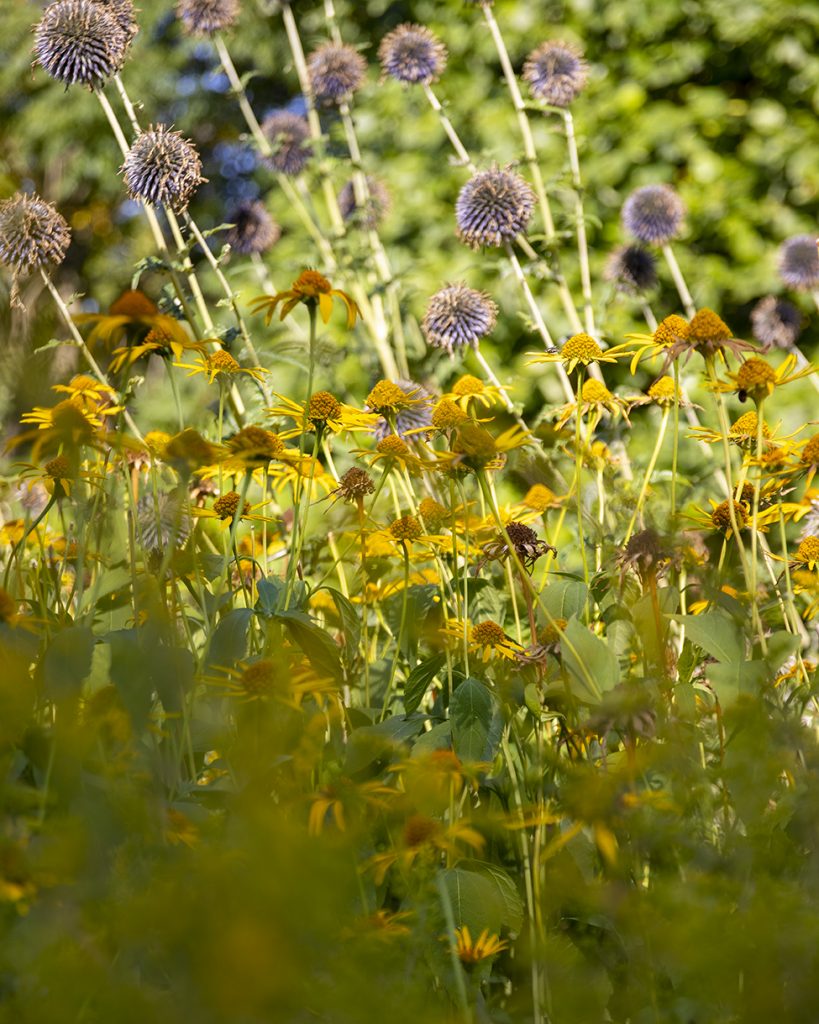
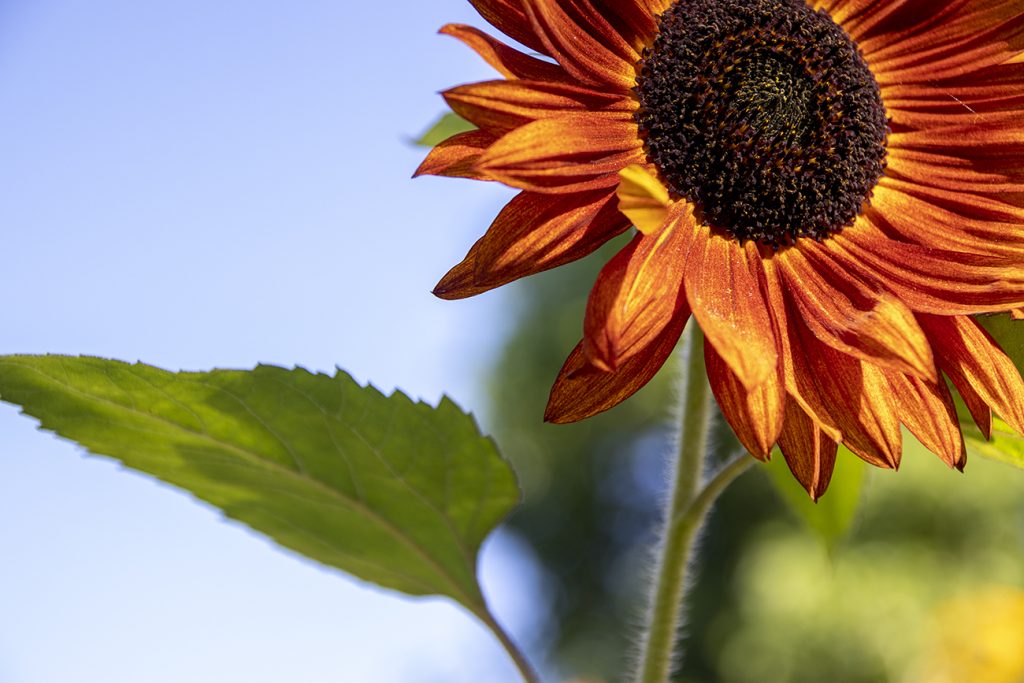
“I suppose I ought to eat or drink something or other; but the great question is ‘What?’”
—Chapter 4, The Rabbit Sends in a Little Bill
Unfortunately, our wonderfully nostalgic boat trip must sadly come to an end. Yet despite the rather sudden nudge back to reality we feel more than happy to prolong our idyllic fantasy with a slow meander through Oxford’s warren of cobbled alleyways in search of something delicious to eat. A long leisurely lunch in the garden courtyard at Wilding consisted of two large grazing platters accompanied by a refreshing Verdejo Rueda wine from Spain. From the light-filled conservatory to the copper and chrome bar, from booths to bistro tables and from an expansive garden terrace landscaped with wildflowers, aromatic herbs and vines from local vineyards, Wilding is a pleasure to visit. With the warm welcome sun on our faces, we could have stayed well into the evening, as one often feels like doing when on holiday. However, the enchantment of a visit to the Oxford Botanic Gardens was too much to resist. With that heightened sense of vacation euphoria we pressed on with a little extra spring in our step. It was a very good wine!
“Have some wine,” the March Hare said in an encouraging tone.
Alice looked all round the table, but there was nothing on it but tea. “I don’t see any wine,” she remarked.
“There isn’t any,” said the March Hare.
“Then it wasn’t very civil of you to offer it,” said Alice angrily.
“It wasn’t very civil of you to sit down without being invited,” said the March Hare.
—Chapter 7, A Mad Tea-Party
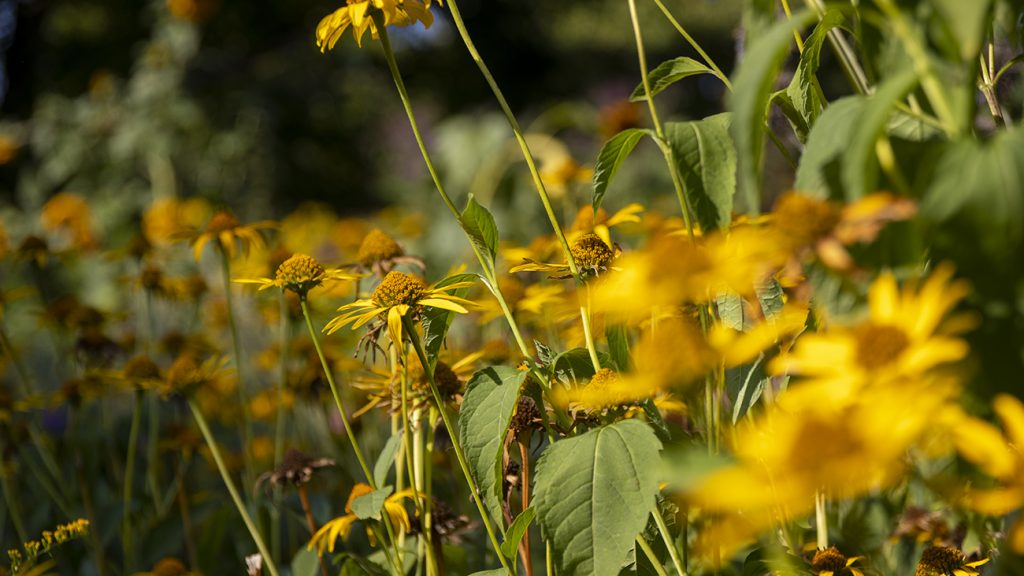
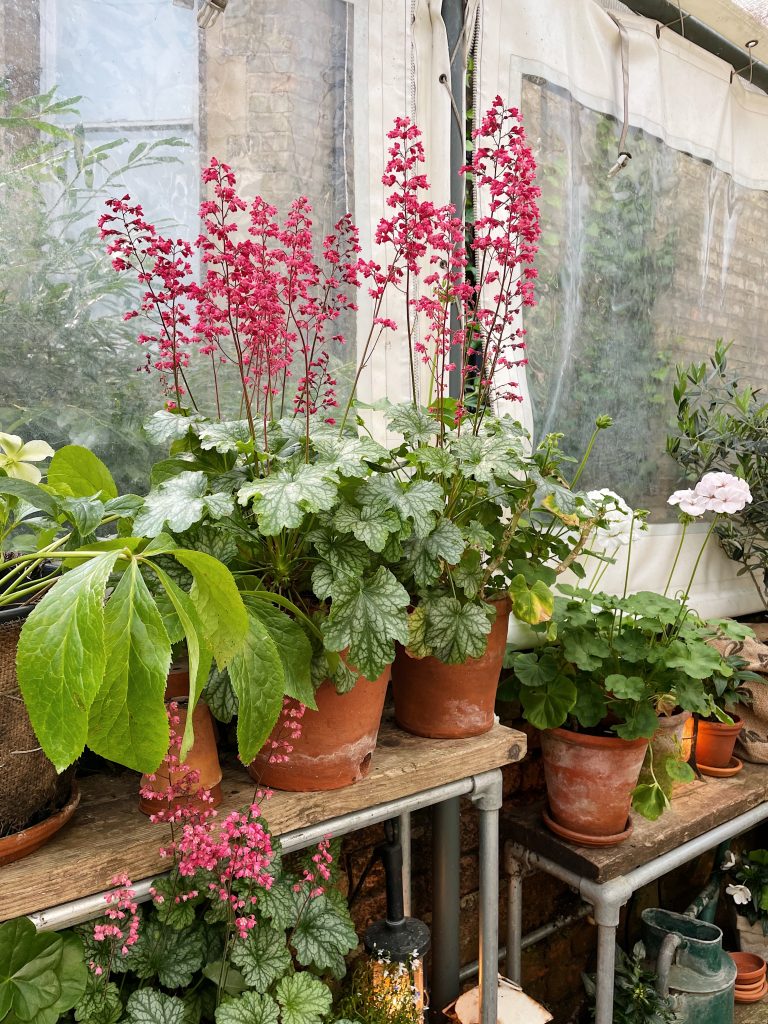
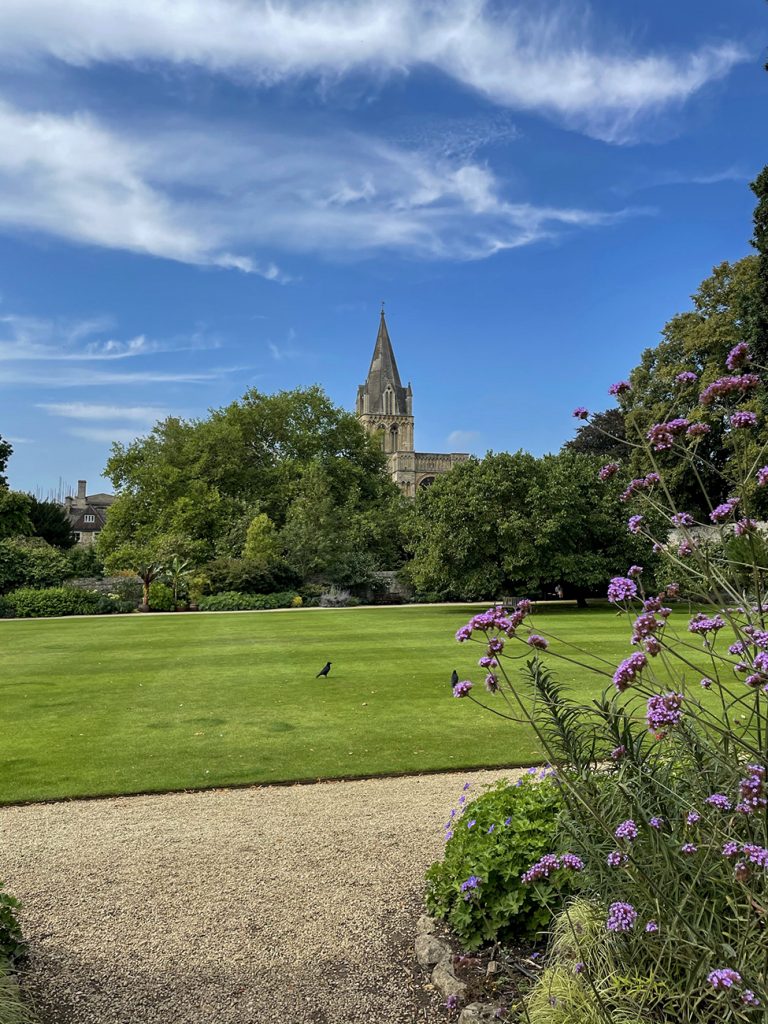
The Botanic Gardens originated as a ‘Physic Garden’ by Henry Danvers, 1st Earl of Danby, in 1621 with a mission “to promote the furtherance of learning and to glorify nature” and grow plants for medicinal research. Hidden behind vast stretches of old brick walls the garden is a botanical haven and an oasis found just a stone’s throw from the bustling main road. The Garden is separated into three sections: The Walled Garden, surrounded by the original seventeenth-century stonework and home to the Garden’s oldest English yew tree. The Glasshouses, where you can see over 1200 different species of plants needing protection from the extremes of British weather. Finally, The Lower Garden the area between the Walled Garden and the River Cherwell. The University of Oxford Botanic Garden is the oldest Botanic Garden in Britain and one of the oldest scientific gardens in the world. With the heat of the day in full swing, we become utterly overwhelmed by the unfurling scene before us. We circle the perimeter in search of respite and find a dozen or so wooden garden benches lining the walls, all in various states of wear depending on their positioning and protection from the elements. Unfortunately, we are not alone in our need to languish in the shade and find that each seat is literally taken. Eventually we locate a resting place and then once satisfactorily recharged we forge on to explore. No matter the garden or location I am always drawn to the geraniums. Bright, punchy flowers with their furry lime-tinged leaves are usually found housed within the warmth of the greenhouses. I leave Dan mesmerised by the gigantic statuesque sunflowers as they turn to face the sun and set off on a floral mission. I love these plants as much for their ability to conjure up sweet images of Mediterranean holidays as I do for their tough, hardy resilience and perfect complement to a weather worn terracotta pot. The ancient clay vessel and these robust perennial plants seem made for each other.

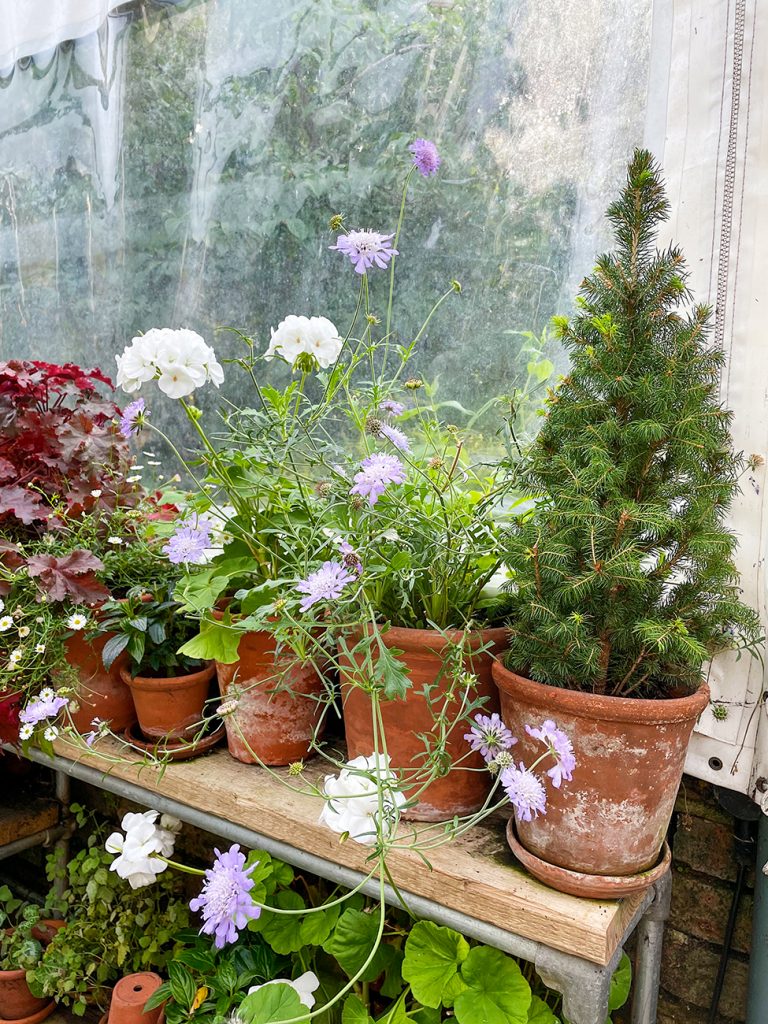
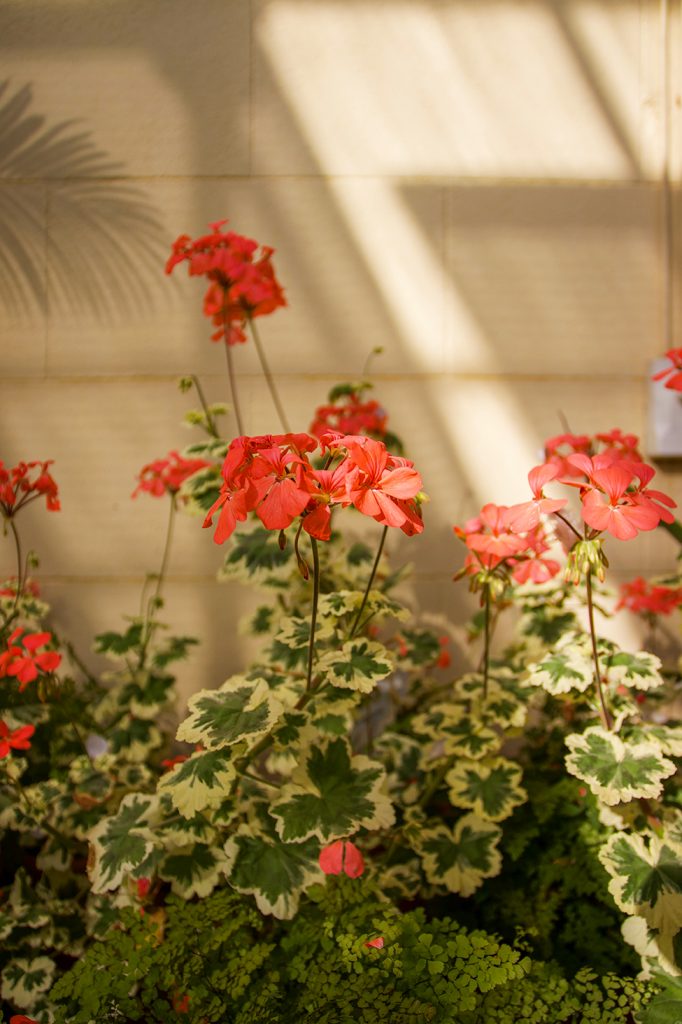

Upon exiting we discovered a compact yet impressive terrace brimming with vivacious, billowy roses in colours that seemed too vivid and perfect to possibly be real. This life affirming garden full of botanical wonder was built in homage to the group of researchers and scientists whose joint work at Oxford University into the isolation and purification of Penicillin was to become a wonder of the scientific world.
Alongside the rose garden is the Daubeny building. Now used mainly as student accommodation, it was originally a laboratory, built at his own expense by Charles Daubeny, Professor of Botany from 1834 to 1867. He was responsible for a major rearrangement of the Botanic Garden. The inscription above the entrance to the building, Sine experientia nihil sufficienter sciri potest (Without experience nothing can be known sufficiently), is from Roger Bacon’s Opus Majus, written in 1267-8. A commemoration to the hard work and determination of the important botanical and scientific research undertaken at the University of Oxford.
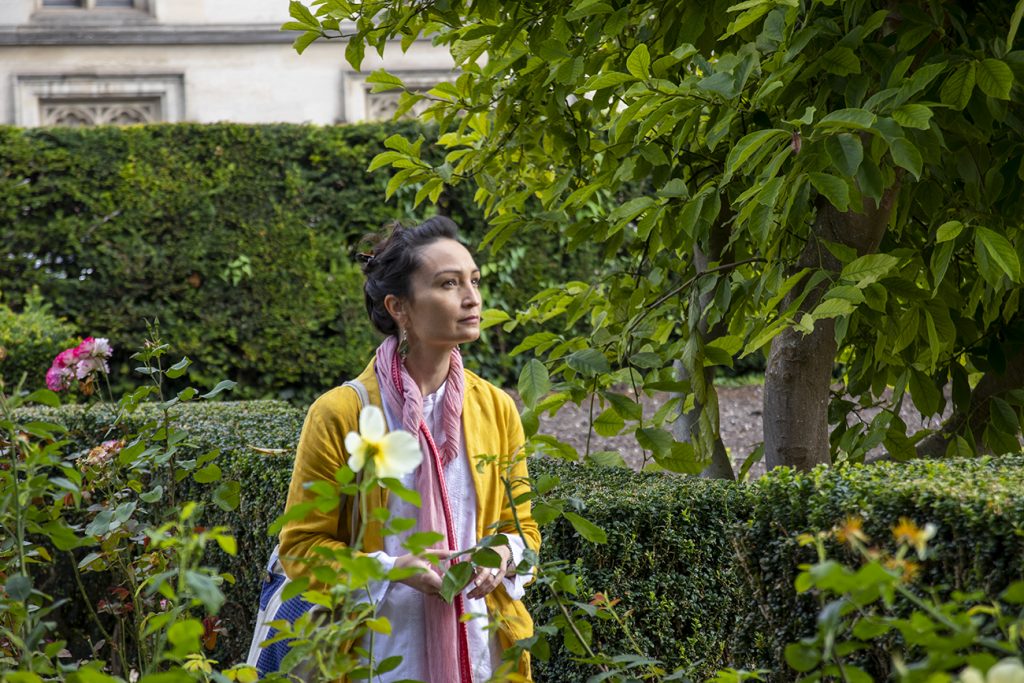
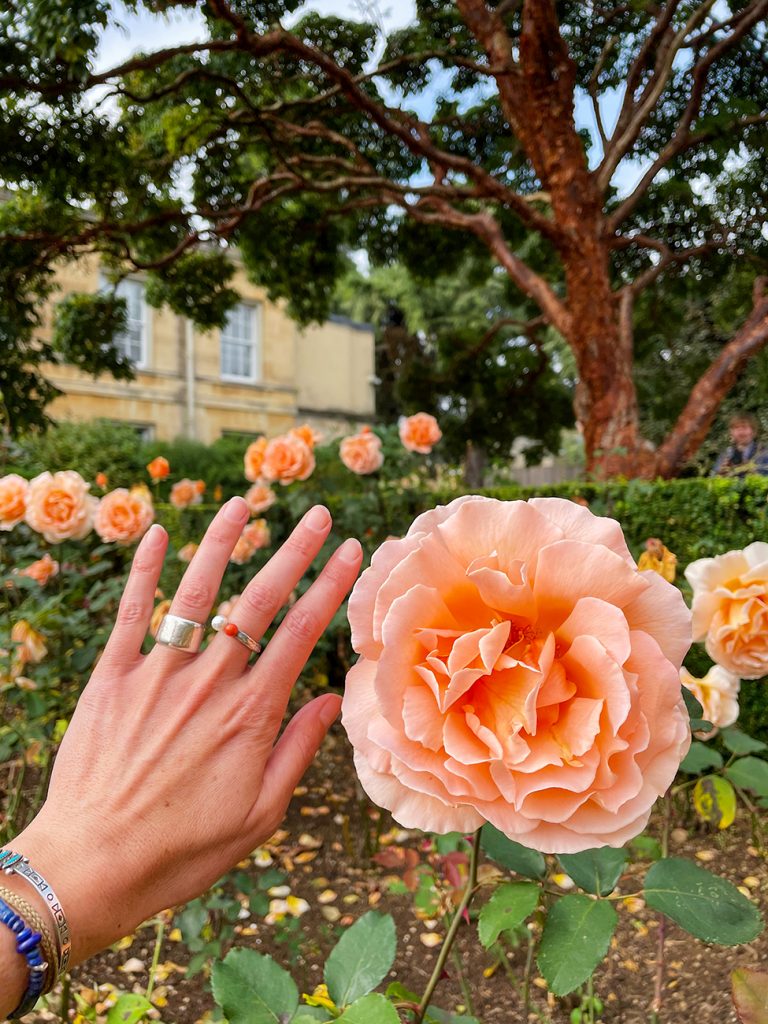

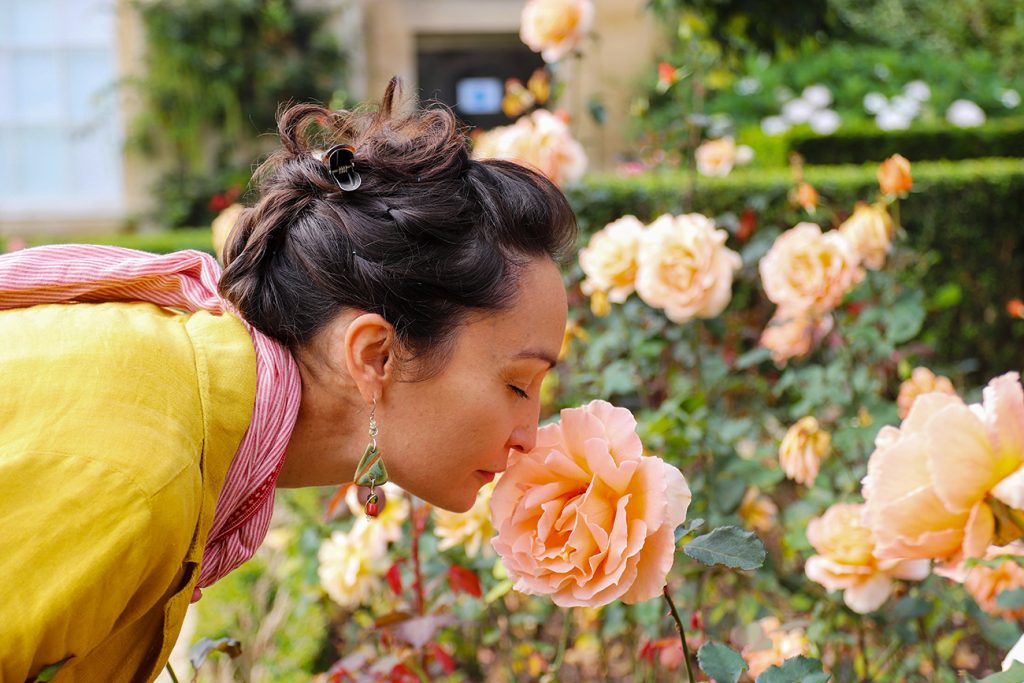
The intoxicating perfume of the rose garden is intensified by the warm September sun and as I wander through the rows of flowers, I find it impossible to resist the urge to touch the delicate blooms. Each petal seems to soak up the sun’s light concentrating the colours and saturating each rose in an almost luminescent aura. With many store-bought flowers distinctly lacking in fragrance nowadays it feels positively rude not to bend down in front of every bud and take a big conspicuous sniff; how often do we take the time to stop and smell the roses, and sadly, when we do allow ourselves this fundamental pleasure, we are usually greeted with a less than satisfactory smell. I therefor take advantage here and breathe it all in, every last petal until my lungs are full to capacity with the scent of a summery weekend spent in idyllic Oxford. Can just an idyl, long weekend really encapsulate everything that’s beautiful about a particular place? Who knows, but I can say with the utmost certainty that I will definitely be back for more.


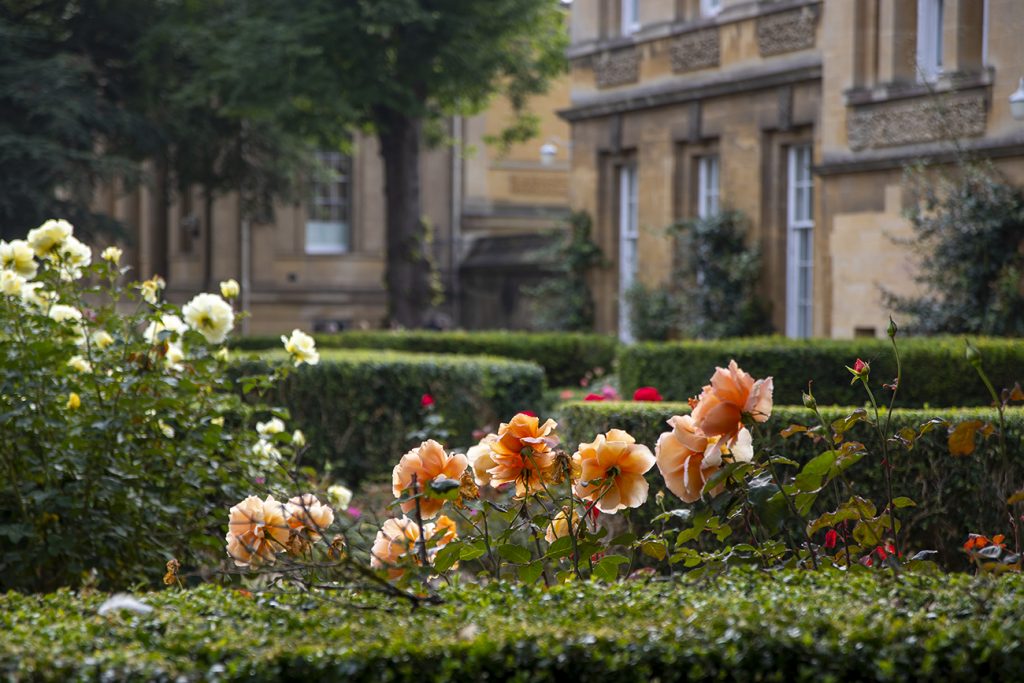
A few recommendations in Oxford
Lovely places to eat
Vaults & Garden An inviting cafeteria style eatery nestled under the vaulted ceiling of a beautiful fourteenth century church, with views from the café garden overlooking historic Radcliffe Square. Warm atmosphere and absolutely delicious homecooked meals built on the principles of sustainability. I can highly recommend the chicken fricassee! Or anything on the menu. I wish there were more eateries like this.
Wilding Beautifully designed eatery set inside a gorgeous old Georgian building, Wilding is a place to enjoy wine and food that is matched and served in a creative and unpretentious way. A balanced menu of Sea, Garden, Field & Dairy caters to all, with plant-based food taking equal billing to suit vegan and vegetarian friends. A picturesque courtyard at the back will make you want to linger just that little bit longer.
The Missing Bean serving specialty coffee, a range of locally made bread, sandwiches prepared in house, as well as a number of homemade cakes on offer, with vegan and gluten free options available. Good for a quick bite to eat and a great coffee!
The Handle Bar Tucked away above a bicycle shop on St Michael’s street, this cosy restaurant, café and bar in central Oxford serving breakfasts, brunches, lunches and dinners.
Oli’s Thai A tiny space whose reputation far outweighs its size. Oli’s is supposed to be incredible. Unfortunately we didn’t book in advance and couldn’t get a table but we’ll definitely organise ourselves next time! I think this review from The Guardian speaks for itself: “…get down here, even if you have to crawl over broken glass”
The Cherwell Boathouse As the name suggests this restaurant sits harmoniously along the water’s edge, tucked out of sight down a narrow leafy lane. Serving top-notch modern British cuisine and known for their wine list which offers excellent value and variety. You can sit and watch the punts glide by and breathe in the tranquil, picturesque surrounds. You can hire a punt from the neighbouring punt station and go for a little tour after lunch. Perfect spot for a special occasion. I recommend going for lunch to take full advantage of the scenery.
Gee’s A restaurant and bar offering locals and visitors a uniquely rustic, Mediterranean dining experience set in a unique Victorian Glasshouse. We sat in the light-filled conservatory amidst olive trees and plants, looking out onto the outside dining area brimming with greenery and seasonal flowers in full bloom. Choose from a daily evolving seasonal menu inspired by the regional dishes of Spain and Italy, cooked on the wood fire oven and charcoal grill.
The Turf Somehow this Oxford institution seems to still be mostly frequented by locals even though it’s on every best Oxford pubs list. You have to know where to find this lovely, Medieval pub – it’s hidden between two small alleyways and entered from another tiny entry. If you manage to track it down you will be pleasantly greeted by a gorgeous flower filled beer garden surrounded by beautiful old brick buildings and a great view of the neighbouring stone church tower. Don’t bother with the wine here, they serve great beer so go with the flow.
The King’s Arms Festooned with baskets of pretty, vibrant flowers this pastel pink pub is one of the oldest in town. Built in 1607 it has become a favourite with locals and students (not a boozy student pub!) and is the perfect spot in the center of town to sit in the sun and watch the world go by.
Lovely places to shop
Objects of Use A beautiful little modern day hardware store with a strong commitment to preserving the heritage of craft by supporting a resurgence of making through collaborations with independent designers and craftspeople. Hand made everyday objects such as brooms, brushes, ceramics, kitchen knives, and tools made by artisans from Japan, Finland, Korea, as well as nearby artisans from Oxford.
Sanders of Oxford A family run Oxford institution, Sanders sell antique prints and maps from the 15th – 20th century, covering virtually every subject and location you can think of. These sit alongside a collection of works by UK based contemporary print makers, priced to suit every pocket. All of the prints and maps they sell are guaranteed original, with no reproductions, copies, or digital prints. One of the few remaining antiquarian print and map galleries left outside of London. The shop location inside the old Salutation Inn has been host to booksellers and printmakers since 1830.
Truck Store is Oxford’s independent music hub, a proper record shop in the heart of the city’s music scene.
TOAST is a British label that creates and curates simple, functional, beautiful clothing, homeware and editorial. One of my favourite brands in the UK! There are 20 TOAST Shops throughout the UK and all the shops are unique and are located in historical market towns or cities.
Oxford Ceramics Gallery is an independent gallery specialising in the exhibition and sale of modern and contemporary studio ceramics. The gallery works with both UK and international artists across generations with a particular focus on British, Danish and Japanese work.
Jericho Cheese Company A small, independently owned cheese shop specialising in high quality cheeses from England, Scotland, Wales, and Ireland. If you like blue cheese as much as I do then try the Brunswick Blue, or my classic favourite Colston Bassett Stilton – delicious! As well as an impressive selection of cheeses you can also find dairy products, chocolate, sourdough bread, and charcuterie.
The Covered Market Centered in the middle of the City, accessed either from the High Street, Market Street or through the Golden Cross in Cornmarket Street, the Covered Market is full of local and independent retailers selling hand made crafts, coffee, food, and fresh flowers.
Blackwell’s Books Another Oxford institution, Blackwell’s first opened its doors on Broad St in 1879 and the current store is still in the original location. Now home to three levels of books and stationary, as well as a rare books section. A must visit for all book lovers, and a little dangerous for your bank balance!
Lovely places to visit
Oxford Botanic Garden and Arboretum is the UK’s oldest botanic garden and occupies a world-class position in terms of its history and academic location. Founded in 1621 the Garden is committed to educating people about the importance of plants, to help conserve plants from around the world, and to support teaching and research within the University and beyond.
Oxford University Museum of Natural History holds an internationally-significant collection of natural history specimens and archives in a stunning example of neo-Gothic architecture. I would highly recommend putting this at the top of your list!
The Ashmolean is the University of Oxford’s museum of art and archaeology, founded in 1683. Our world famous collections range from Egyptian mummies to contemporary art, telling human stories across cultures and across time. There is a lovely rooftop café to enjoy lunch or Afternoon Tea and gaze out over the picturesque panorama of Oxford.
Pitt Rivers Museum Founded in 1884, it houses within an atmospheric building more than 500,000 objects, photographs and manuscripts from all over the world, and from all periods of human existence. Within these are exceptional objects of ritual significance, and objects made for tourists or trade. Adjacent to the Natural History Museum so it is possible to visit both in a single visit.
Oxford River Cruises We used this company for our river cruise which led us through the picturesque scenery along the famous Regatta course. They also offer cocktail cruises, dinner and picnic cruises, as well as walking tours around the historical center.
The Bodleian Library is actually a series of interconnected libraries dotted throughout Oxford that are collectively referred to as the Bodleian Libraries. The collective has an impressive history – some of its buildings have been libraries since the Middle Ages. The Neo Gothic architecture is as impressive as the contents within and the libraries are one of the biggest and oldest in Britain.
The Radcliffe Camera is relatively modern by Oxford standards and was only built in the 18th century. It currently functions as one of the main reading rooms of the Bodleian Library as well as the home of several of the library’s collections. All of The Bodeian Libraries are functioning libraries so are off limits to visit unless you book a guided tour.
Christ Church College is one of the most beautiful colleges in Oxford with its impressive stone buildings in a blend of English Gothic and Romanesque architecture. The façade is almost entirely covered in ivy which only adds to the building’s grandeur. You can pay to visit inside the grounds, or simply admire the incredible architecture for free. Christ Church College is also home to Oxford’s cathedral.
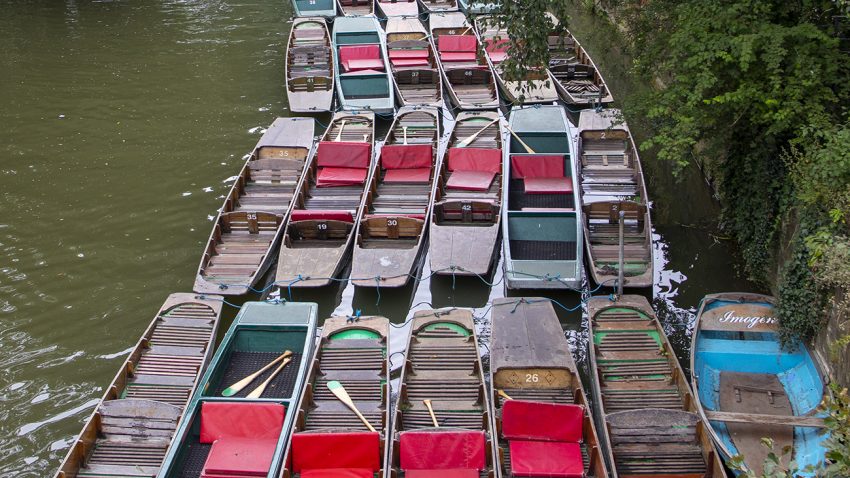
A beautiful meander.
Thanks Les! So glad you enjoyed it.
Rose x
Wow! That’s a long read! Oxford to me is a historical town full of beautiful architecture. Definitely worth a revisit as my memory of Oxford is getting rather vague. River cruises are always very idyllic, with the soft lapping water against the sides of the boats. Your travelogue is Alice’s travel in wonderland above ground! Love it.
I couldn’t agree more Sandie. And my favourite things to do on holiday are boat trips, walking tours and bike tours if possible. You can get such a great sense of a place that way, especially with a knowledgeable local guide.
So glad you enjoyed part 2. It made me want to go back too!
Rose x
Wow Oxford just seems so beautiful and magical and I am definitely going to need to visit sometime soon. No wonder it has generated so much literary and scientific talent. Beautiful photos Rose and thanks for the shopping and cafe tips!
Yes Oxford is a wonderful city, so full of energy and steeped in history. The architecture alone will lure me back. And that Rose garden is incredible is you’re lucky enough to time your visit to witness maximum bloom!
Rose x